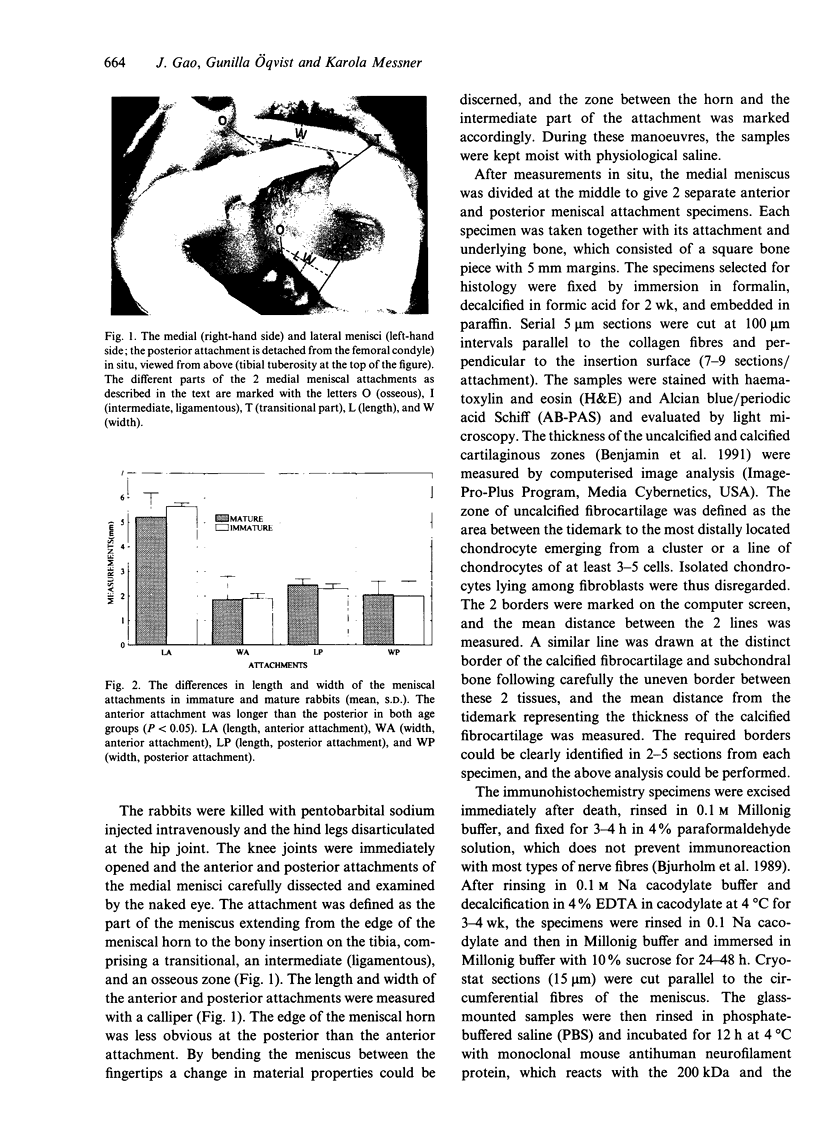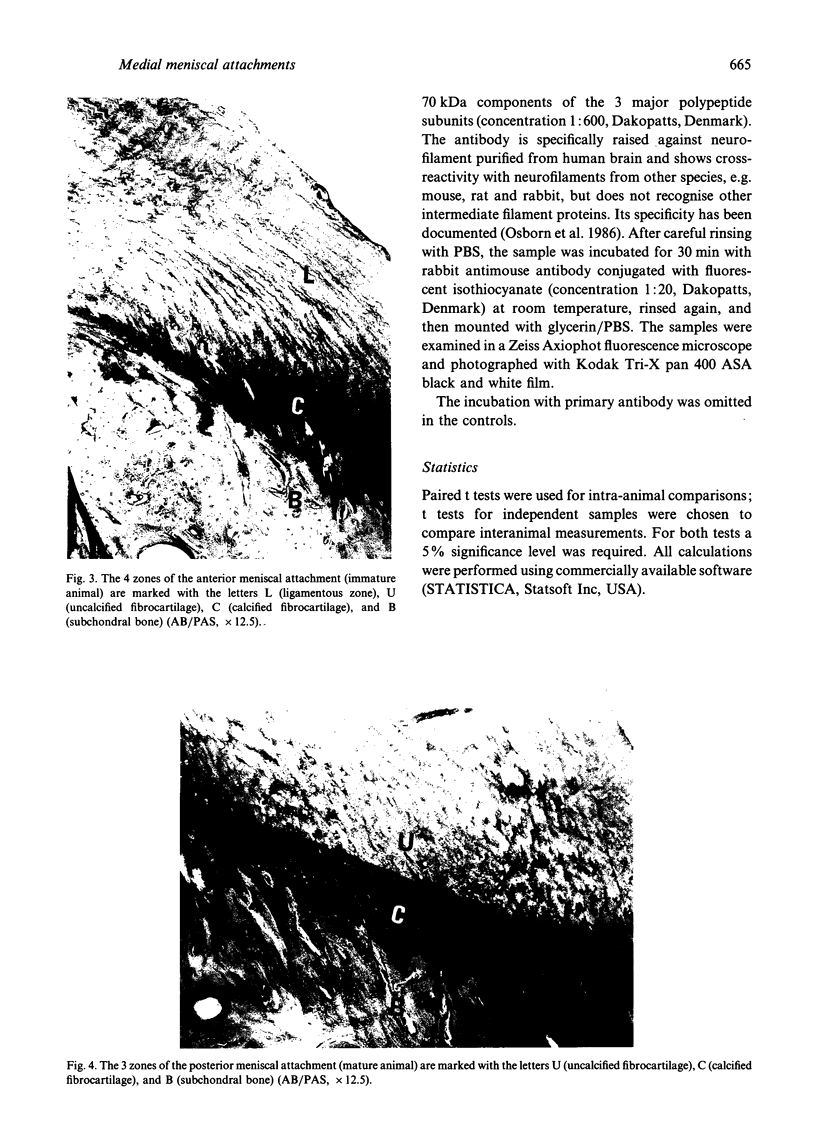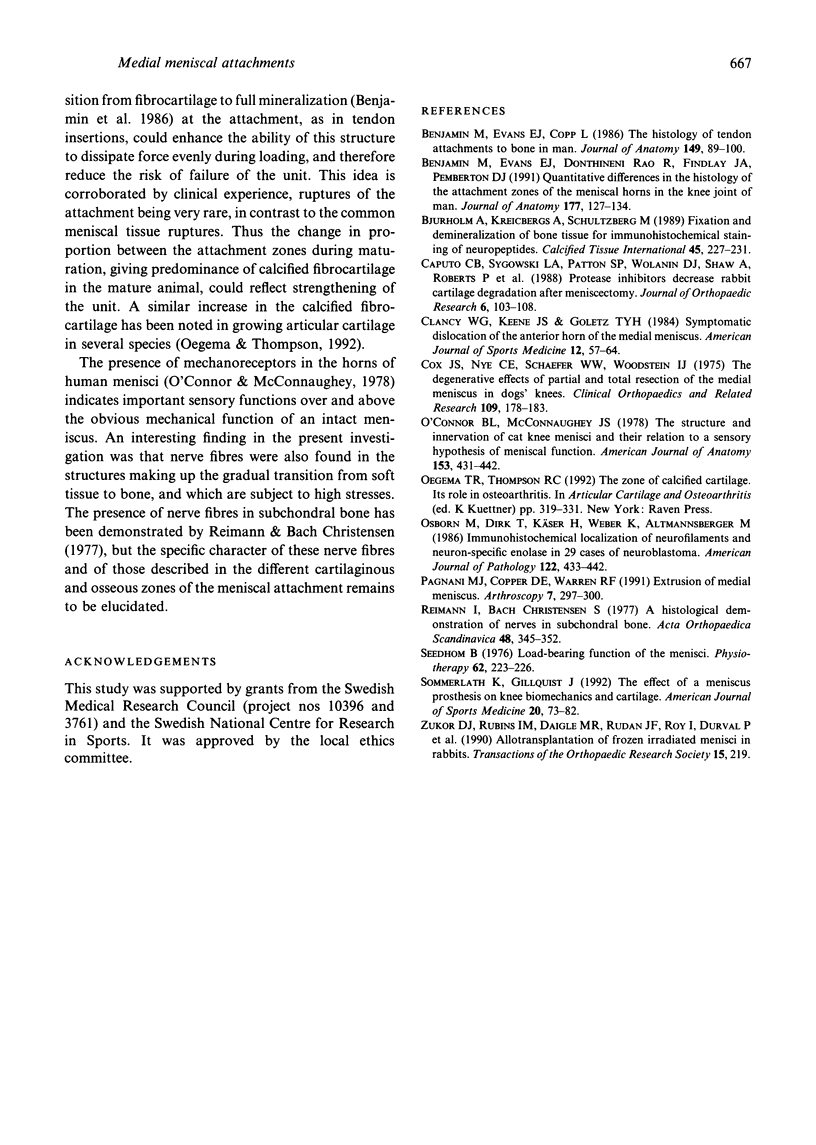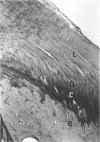Abstract
In the search for a suitable experimental model the rabbit has increasingly been used for investigations on the meniscus. The present study focused on the morphology and innervation of the anterior and posterior medial meniscal attachments in adolescent and adult rabbits in comparison with man. Grossly, the posterior attachment has a similar anatomical position as in man, but the anterior is inserted more anteriorly and more laterally, with a long ligament-like structure between the osseous insertion and the meniscal horn. As in man, the attachment resembles a ligamentous insertion and contains zones of uncalcified and calcified fibrocartilage and subchondral bone. The proportion of the calcified cartilaginous zone in the attachment increases during maturation as in articular cartilage. Nerve fibres were found not only at the horns but also in the uncalcified and calcified fibrocartilaginous zones and the underlying bone. The differences between rabbit and human menisci should be borne in mind when interpreting data from animal experiments.
Full text
PDF




Images in this article
Selected References
These references are in PubMed. This may not be the complete list of references from this article.
- Benjamin M., Evans E. J., Copp L. The histology of tendon attachments to bone in man. J Anat. 1986 Dec;149:89–100. [PMC free article] [PubMed] [Google Scholar]
- Benjamin M., Evans E. J., Rao R. D., Findlay J. A., Pemberton D. J. Quantitative differences in the histology of the attachment zones of the meniscal horns in the knee joint of man. J Anat. 1991 Aug;177:127–134. [PMC free article] [PubMed] [Google Scholar]
- Bjurholm A., Kreicbergs A., Schultzberg M. Fixation and demineralization of bone tissue for immunohistochemical staining of neuropeptides. Calcif Tissue Int. 1989 Oct;45(4):227–231. doi: 10.1007/BF02556042. [DOI] [PubMed] [Google Scholar]
- Caputo C. B., Sygowski L. A., Patton S. P., Wolanin D. J., Shaw A., Roberts R. A., DiPasquale G. Protease inhibitors decrease rabbit cartilage degradation after meniscectomy. J Orthop Res. 1988;6(1):103–108. doi: 10.1002/jor.1100060113. [DOI] [PubMed] [Google Scholar]
- Clancy W. G., Keene J. S., Goletz T. H. Symptomatic dislocation of the anterior horn of the medial meniscus. Am J Sports Med. 1984 Jan-Feb;12(1):57–64. doi: 10.1177/036354658401200109. [DOI] [PubMed] [Google Scholar]
- Cox J. S., Nye C. E., Schaefer W. W., Woodstein I. J. The degenerative effects of partial and total resection of the medial meniscus in dogs' knees. Clin Orthop Relat Res. 1975;(109):178–183. doi: 10.1097/00003086-197506000-00026. [DOI] [PubMed] [Google Scholar]
- O'Connor B. L., McConnaughey J. S. The structure and innervation of cat knee menisci, and their relation to a "sensory hypothesis" of meniscal function. Am J Anat. 1978 Nov;153(3):431–442. doi: 10.1002/aja.1001530306. [DOI] [PubMed] [Google Scholar]
- Osborn M., Dirk T., Käser H., Weber K., Altmannsberger M. Immunohistochemical localization of neurofilaments and neuron-specific enolase in 29 cases of neuroblastoma. Am J Pathol. 1986 Mar;122(3):433–442. [PMC free article] [PubMed] [Google Scholar]
- Pagnani M. J., Cooper D. E., Warren R. F. Extrusion of the medial meniscus. Arthroscopy. 1991;7(3):297–300. doi: 10.1016/0749-8063(91)90131-g. [DOI] [PubMed] [Google Scholar]
- Reimann I., Christensen S. B. A histological demonstration of nerves in subchondral bone. Acta Orthop Scand. 1977;48(4):345–352. doi: 10.3109/17453677708992006. [DOI] [PubMed] [Google Scholar]
- Seedhom B. B. Loadbearing function of the menisci. Physiotherapy. 1976 Jun 10;62(7):223–223. [PubMed] [Google Scholar]
- Sommerlath K., Gillquist J. The effect of a meniscal prosthesis on knee biomechanics and cartilage. An experimental study in rabbits. Am J Sports Med. 1992 Jan-Feb;20(1):73–81. doi: 10.1177/036354659202000117. [DOI] [PubMed] [Google Scholar]






